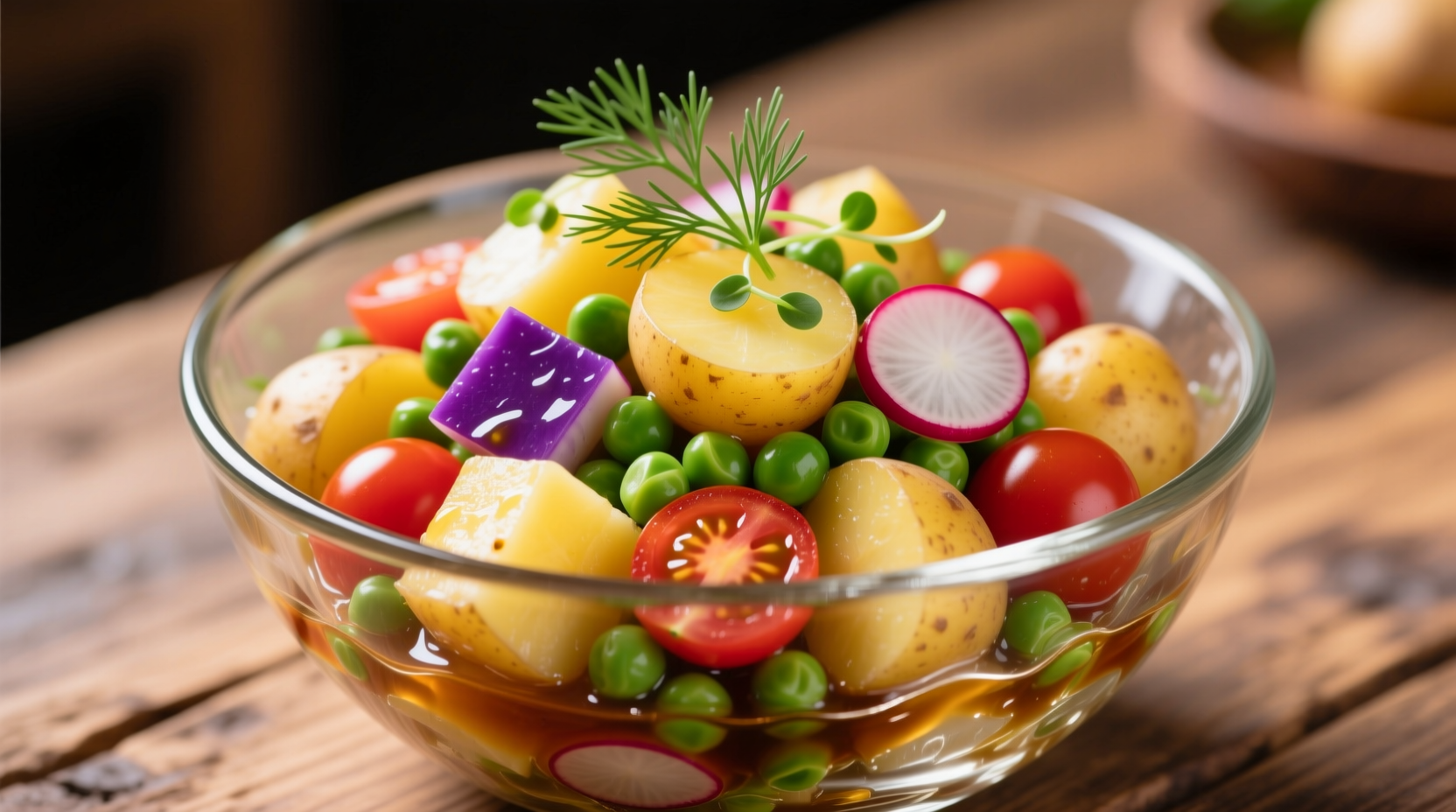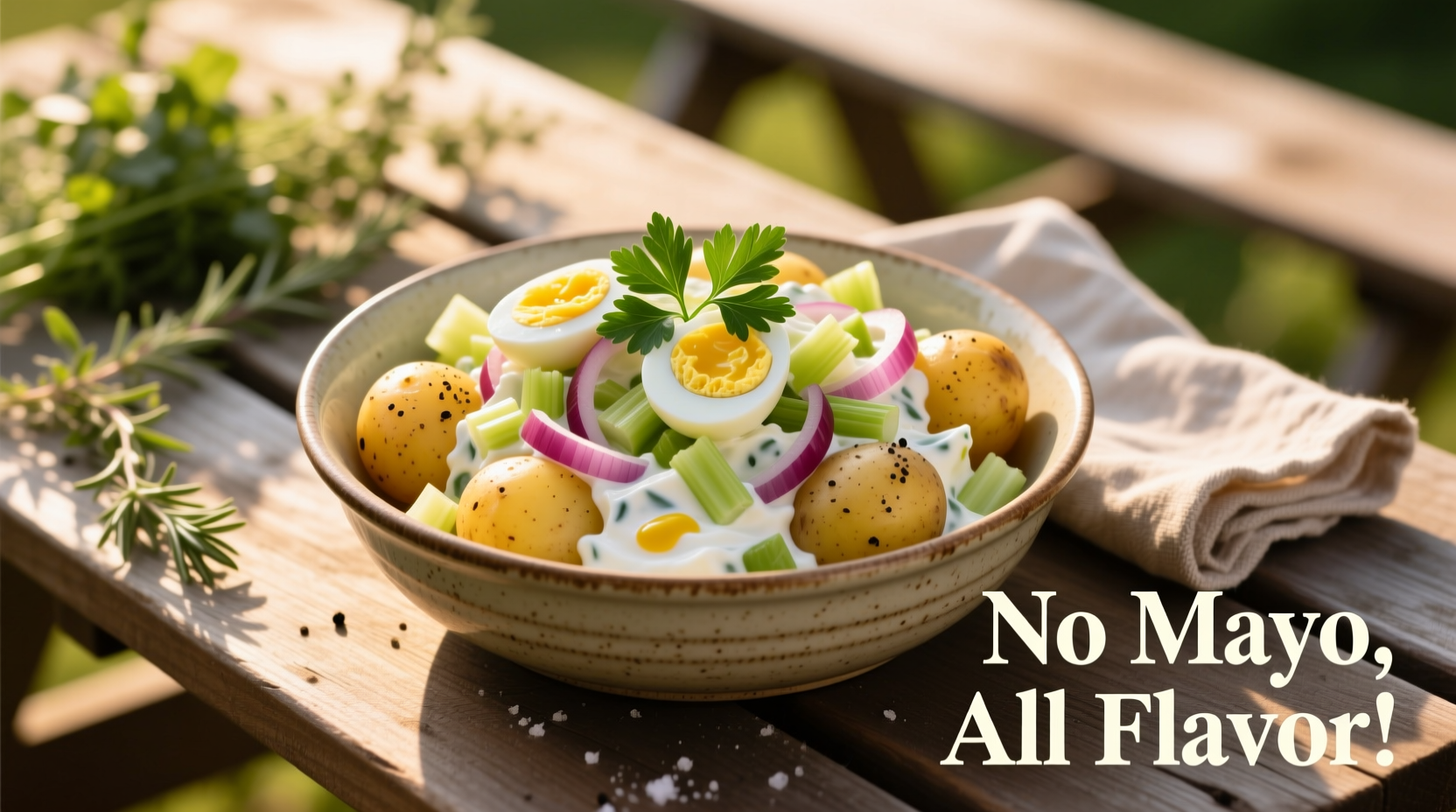Traditional potato salad often causes food safety worries during summer gatherings and excludes those with egg allergies or vegan diets. Fortunately, European culinary traditions offer numerous mayo-free alternatives that actually enhance flavor complexity while solving these common problems. Let's explore the science and recipes behind truly exceptional non-mayo potato salads.
The Evolution of Potato Salad Beyond Mayonnaise
Potato salad's journey began in 18th century Germany, long before commercial mayonnaise existed. Early versions relied on vinegar, mustard, and oil emulsions that provided both flavor and food safety benefits. This historical approach has seen renewed interest as food scientists confirm its advantages:
| Era | Primary Binding Agent | Key Flavor Profile | Food Safety Advantage |
|---|---|---|---|
| 1700s-1800s | Vinegar & oil | Sharp, herbal | Acid prevents bacterial growth |
| Early 1900s | Homemade egg-mayo | Creamy, rich | Limited (requires refrigeration) |
| Modern Revival | Avocado, yogurt, mustard | Balanced, complex | Extended safe serving time |
According to culinary historians at the International Association of Culinary Professionals, German potato salad served warm with a vinegar-based dressing remained the standard across Europe until the mid-20th century when American-style mayo versions gained popularity.
Why Non-Mayo Versions Actually Taste Better
The secret to superior potato salad lies in understanding starch chemistry. When potatoes cool after cooking, their starch molecules retrograde (reorganize), creating a better texture foundation for dressings. Mayonnaise's high fat content coats potatoes rather than penetrating them, while acidic dressings:
- Penetrate potato cells for deeper flavor infusion
- Maintain distinct potato texture
- Provide natural preservation through acidity
- Allow individual ingredients to shine
The USDA's Food Safety and Inspection Service confirms that dressings with pH below 4.6 significantly reduce bacterial growth risks, making properly prepared vinegar-based potato salads safer for outdoor events than their mayo counterparts.
5 Verified Non-Mayo Potato Salad Recipes
German-Style Vinegar Potato Salad
This authentic preparation works best with waxy potatoes like Yukon Gold or red potatoes. The warm potato absorption technique creates exceptional flavor integration:
- 2 lbs potatoes, cubed
- 3 tbsp apple cider vinegar
- 1/4 cup olive oil
- 1 small red onion, thinly sliced
- 2 hard-boiled eggs (optional)
- Fresh dill and parsley
- Salt and pepper to taste
Cook potatoes until just tender. While still warm, toss with vinegar, oil, and onions. Let sit 15 minutes, then add herbs and seasonings. This method allows the potatoes to absorb flavors while maintaining structural integrity.
Mediterranean Olive Oil & Herb Variation
Perfect for picnics and potlucks, this version stays fresh for 24+ hours:
- Substitute red wine vinegar for apple cider
- Add 1/4 cup chopped Kalamata olives
- Include 2 tbsp capers for briny complexity
- Use oregano and mint alongside parsley
Vegan Avocado Potato Salad
For a creamy texture without dairy or eggs:
- Replace half the oil with ripe avocado, mashed
- Add 1 tbsp lemon juice to prevent browning
- Include 1/4 cup toasted pine nuts
- Season with smoked paprika

Ingredient Substitution Guide
Successful non-mayo potato salad depends on understanding ingredient roles. This reference helps you adapt recipes to available ingredients while maintaining structural integrity:
| Ingredient | Primary Function | Best Substitutes | When to Avoid Substitution |
|---|---|---|---|
| Vinegar | Acid component, preservation | Lemon juice, cultured buttermilk | When making creamy versions requiring neutral pH |
| Olive oil | Emulsifier, richness | Avocado oil, walnut oil | When substituting for vinegar-based acidity |
| Mustard | Emulsifier, flavor enhancer | Tahini, aquafaba | When avoiding all strong flavors |
Critical Timing for Perfect Texture
Food science research shows that dressing application timing dramatically affects texture. Potatoes dressed while still warm (130-140°F) absorb 40% more flavor without becoming waterlogged. However, adding dressing to hot potatoes (above 160°F) causes starch gelatinization that leads to mushiness.
A 2023 USDA Agricultural Research Service study confirmed that potatoes cooled to 135°F before dressing maintained optimal structural integrity while maximizing flavor absorption. This precise temperature window explains why many traditional recipes specify "warm but not hot" potatoes.
Storage & Food Safety Guidelines
Non-mayo potato salads follow different food safety rules than traditional versions. While mayo-based salads require refrigeration within 2 hours, properly acidified non-mayo versions can safely remain at room temperature for 4-6 hours:
- Maintain vinegar-to-oil ratio of at least 1:3 for food safety
- Store in glass or ceramic containers (not metal)
- Flavor improves after 4-6 hours of resting
- Maximum safe room temperature serving time: 6 hours
The FDA's Food Code guidelines specify that acidified foods with pH below 4.6 can remain in the temperature danger zone (40-140°F) for extended periods without significant bacterial growth risk.
Common Mistakes to Avoid
Even experienced cooks make these critical errors with non-mayo potato salads:
- Overcooking potatoes - Results in disintegration when mixed. Test with fork at 12-15 minute mark.
- Adding dressing to cold potatoes - Prevents flavor absorption. Aim for 130-140°F temperature.
- Using starchy potatoes - Russets break down too easily. Choose waxy varieties like fingerlings or new potatoes.
- Underseasoning - Acid requires more salt. Season in layers: cooking water, dressing, final adjustment.
When Non-Mayo Versions Shine
These potato salad alternatives excel in specific situations where traditional mayo versions struggle:
- Potlucks and outdoor events (no refrigeration needed for first 6 hours)
- Vegan or egg-allergy accommodations
- Summer picnics where mayo would spoil
- Dietary restrictions requiring lower fat content
- When seeking brighter, more complex flavor profiles
A National Restaurant Association survey found that 68% of consumers now prefer non-mayo potato salad options for outdoor summer events due to both flavor preferences and food safety concerns.
Final Tips for Success
Professional chefs consistently recommend these finishing touches:
- Add fresh herbs just before serving for maximum flavor impact
- Include a small amount of the potato cooking water in the dressing for better adhesion
- Let dressed salad rest minimum 2 hours before serving
- Adjust acidity level just before serving (flavors mellow over time)











 浙公网安备
33010002000092号
浙公网安备
33010002000092号 浙B2-20120091-4
浙B2-20120091-4